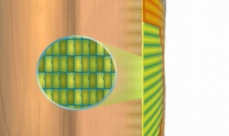Transcription of video clip Grow or die
Secondary growth in trees

© Jardin botanique de Montréal
Cambium, sapwood, and phloem.
How does the trunk thicken? Through periclinal divisions in the cambium.
Here is the cambium, in green. In beige, the sapwood. In orange, the phloem.
The cambium divides, growing thicker. The newly created layer of cells becomes specialized as either sapwood (beige) or phloem (orange).
The layers of sapwood remain in place once they have been produced, whereas the phloem and the cambium are pushed towards the periphery.
This is how the sapwood and the phloem are formed, layer by layer.

© Jardin botanique de Montréal
Anticlinal divisions of the cambium
How does the cambium adjust to the ever-increasing circumference of the trunk?
By multiplying: this is anticlinal division. The cambial cells divide and then grow, thus recovering their original size.
These divisions, which multiply the number of cambial cells, allow the cambium to adjust to the increasing diameter of the trunk.
Back to video clip




